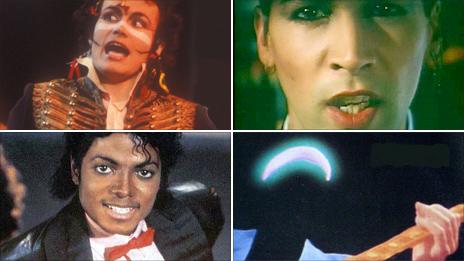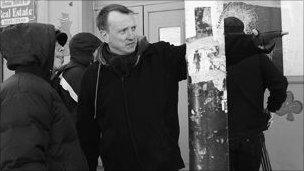Adam Ant to Michael Jackson: Shaping the MTV landscape
- Published

Barron says he "didn't have to do a lot to cause a stir" in early 80s music videos
Music video director Steve Barron made some of the most groundbreaking promos of the 1980s working with artists including Madonna, Michael Jackson, Whitney Houston, Paul McCartney and David Bowie.
He first made videos for The Jam - including Going Underground, released in March 1980 - before working with The Nolans and on other "very middle-of-the-road stuff" before "the cooler stuff came along".

Steve Barron went on to direct films including Coneheads and Mike Bassett: England Manager
He says that, relatively speaking, video budgets are much smaller than in the 1980s when he would get up to £200,000 to make a promo.
"At the time, what we were doing was harder to do but you didn't have to do a lot to cause a bit of a stir," he says.
"Now, you can get there really quickly, really simply - the machinery is pretty amazing but everyone's seen it in every movie and fantasy films."
He adds: "It's hard to innovate, it's hard to push through so you've really got to come up with the idea."
Barron, now 54, stopped making pop videos in 1991 and went on to direct films including Coneheads and Mike Bassett: England Manager.
Here he remembers the making of Antmusic by Adam and the Ants - released 30 years ago on Monday - Don't You Want Me by the Human League, Billie Jean by Michael Jackson and Money for Nothing by Dire Straits.
Antmusic - Adam and the Ants (Dec 1980)
Antmusic - Adam and the Ants
This was his first video and it was also a turning point in my career.
The actual concept - one of the few times - came from the artist.
This was a guy who was out of art college and he had strong graphic ideas like the giant plug unplugging a jukebox.
Adam really helped pull the image side of videos up a couple of notches.
After Adam, with new bands, record companies said: "Well, you've got to be handsome and extreme and out there and completely different."
And Duran Duran and all that kind of thing came out of that.
I think he deserves a lot more credit as an artist for the shake-up he helped cause in the early 80s.
With Antmusic, we also shot down an alleyway on Arlington Road where all the bums live in Camden Town.
Some of them were transported to a different time seeing Adam and his band out there looking like they were from another era.
There was a fair amount of abuse came flying and, I think, a few empty bottles were hurled.
Don't You Want Me - The Human League (Dec 1981)
Don't You Want Me - Human League
That was the second song played when MTV began in America - it was played after Video Killed the Radio Star by Buggles.
It went to number one pretty quickly.
We got a little more budget for this one so we wanted to do something really cinema.
It was a little bit of an homage to a Francois Truffaut film, Day For Night.
And so we wanted to do it the way that was made, a film within a film - you see the crew and the making of.
I remember meeting Phil Oakey for the first time and he said: "I don't wanna be a pop star."
And I said to him: "You're too late for that because this is going to be such a big hit."
The record company knew it was going to be a big number one.
The Human League had that dour Sheffield attitude - that slit-my-wrists vibe.
They were great, the way they went creatively, the haircuts. The whole thing - and the vibe of the song - was really good and tongue-in-cheek.
It was just a great period, I felt, for music.
Things were being reinvented and melody was clashing with style and anarchy without losing the melody. That was so powerful.
Billie Jean - Michael Jackson (Jan 1983)
Billie Jean - Michael Jackson
He'd seen the Don't You Want Me video - that's why I got the job.
And he wanted something cinematic, as well, and his management said he was really into Peter Pan and could we do something that was a little magical?
I'd had an idea the previous year to do a Midas touch video with everything lighting up so the paving stone idea came from that.
The process was pretty straightforward really; we sent the idea to him and went out to LA and shot the video.
Before we shot it, he had a really nice idea for another little scene within it where mannequins come to life and dance behind him and I thought it was a great idea.
We made the video before the album, Thriller, had come out. It was like five weeks before Billie Jean was going to come out and they wouldn't pay for the extra tailor's dummies and the dancers so we had to can that idea.
Obviously, one month later he got anything he wanted for the rest of his life, but right then he wasn't quite in a position yet to demand what he wanted.
He was a really soft-spoken, sweet guy.
Obviously, he was very curious about everything, he wanted to know what was going on with this and that and how that worked.
Then suddenly… I was operating the camera for it as well and the moment he started to dance in that little chorus, it was just so dynamic, it was breathtaking.
I remember the camera steaming up because it was pretty stunning.
You knew that something special was going to arrive on the scene.
This was one of the first videos by a black artist on MTV.
Money for Nothing - Dire Straits (July 1985)
Money For Nothing - Dire Straits
Knopfler wasn't into videos at all, he was into the purity of music and felt that somebody going and putting visuals to it was like drawing all over it.
He felt it would disfigure and distort his music, giving it different emotions and different atmospheres.
As a result, we were in Budapest kind of pretending we were doing a live shoot with him at a gig.
But then we did the computer-generated Money For Nothing man.
CGI animation was new at the time and it was being used just for corporate logos - the letters and things - so it was just borrowed from that and we got the CG guy to create characters out of it.
We then felt that, if we didn't do something with the live footage, the coarseness of how it was put together with the character and the computer animation would be too rough.
I was keeping an eye on new technology and this machine had just come out called Paintbox - you could paint on the frames or manipulate the frames, literally frame by frame.
Me and a couple of friends bought one. That's how the effect with the blacked-out background and Knopfler's illuminated blazer, guitar and headband came about.
We painted on the live footage to weave it together. We just had some people working with Paintbox day and night because we only had a month on that.
But you make things fit the schedule, you make them fit the budget.
Sometimes you get lucky. You take shortcuts and sometimes those shortcuts are more interesting.
It's woven with naivety because we weren't really coming off of anything else because, with those videos, we were doing stuff that we really hadn't seen before.